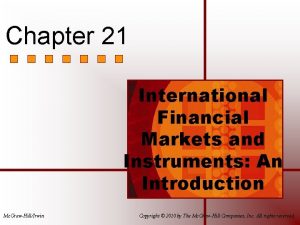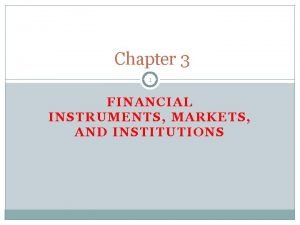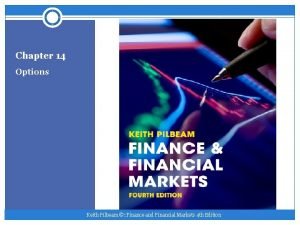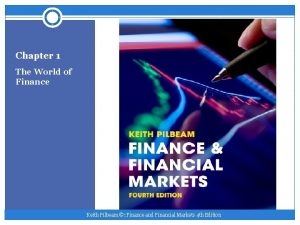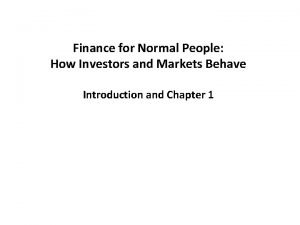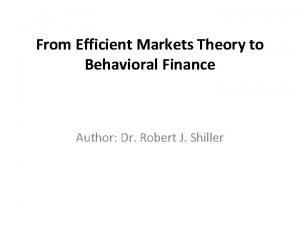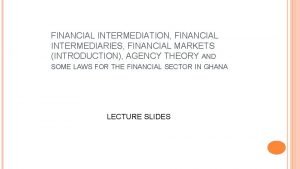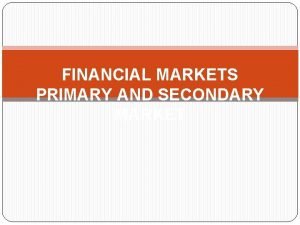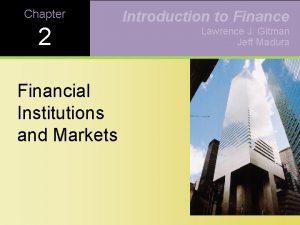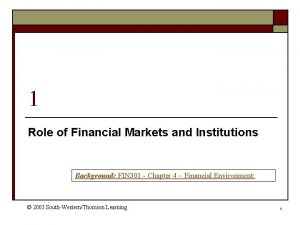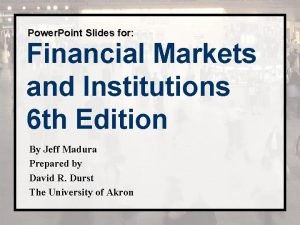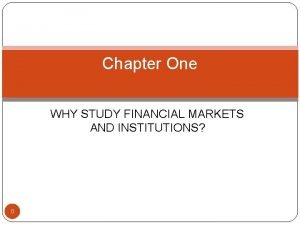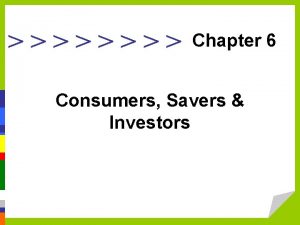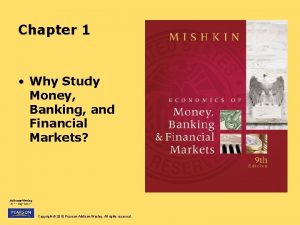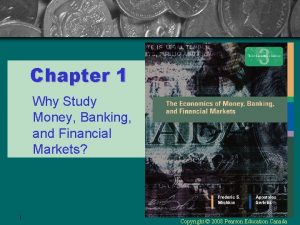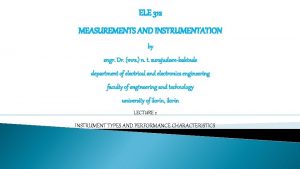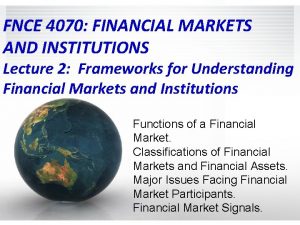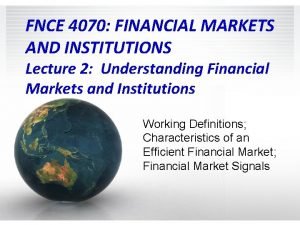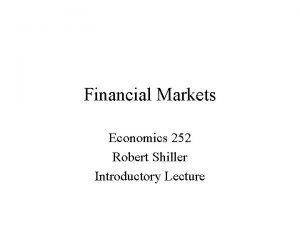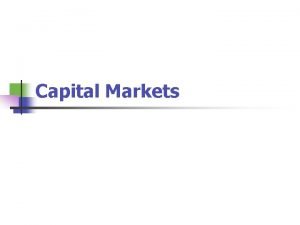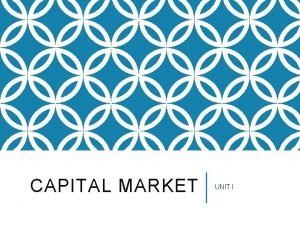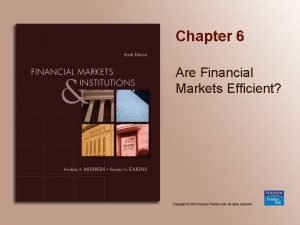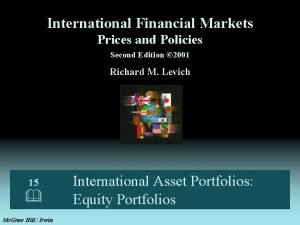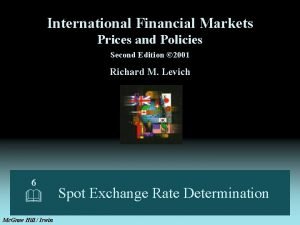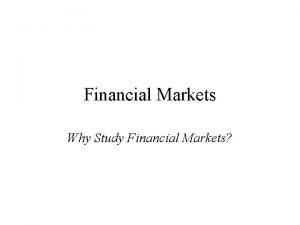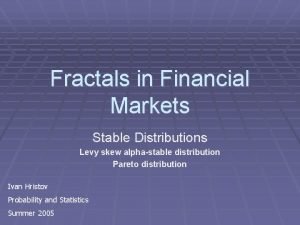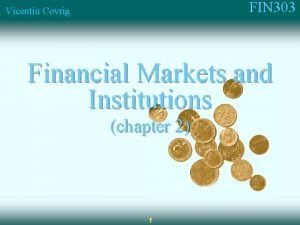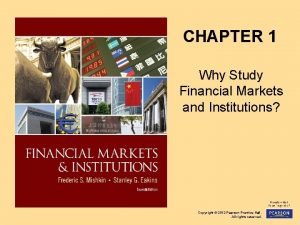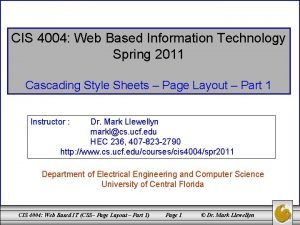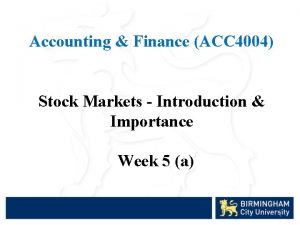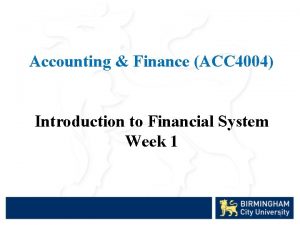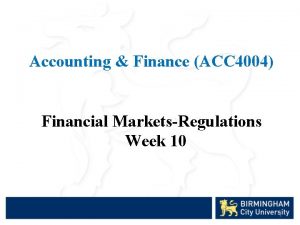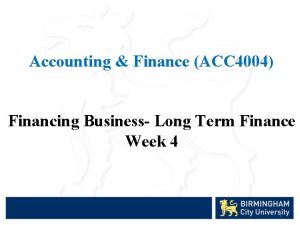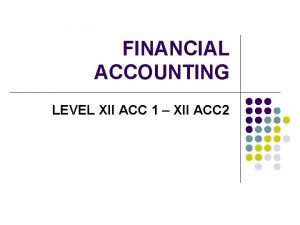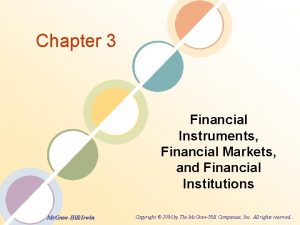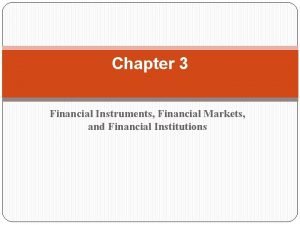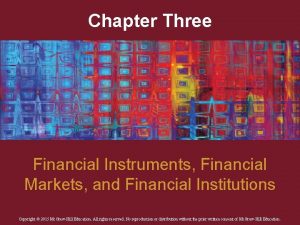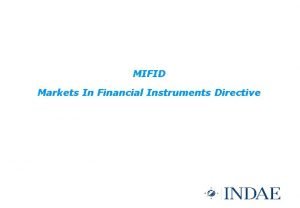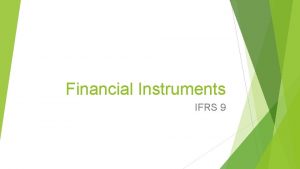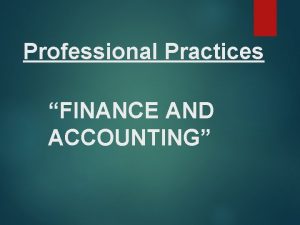Accounting Finance ACC 4004 Financial Markets and Instruments









































- Slides: 41

Accounting & Finance (ACC 4004) Financial Markets and Instruments Week 2 (14) 1

Learning Objectives: • What are Financial markets? • Functions of Financial Markets • Types of Financial markets • Financial Instruments and their functions • Information Asymmetry, Adverse Selection and Moral hazard in financial markets 2

Financial Market(s) “An organisational framework within which financial instruments can be bought and sold” Howells & Bain 2007: 17 “Markets in which funds are transferred from people who have a surplus of available funds to people who have a shortage of available funds” Mishkin & Eakins 2009: 4

Features of Financial Markets – Lending and Borrowing – Liquidity – Price Determination – Risk Sharing – Assimilation and Co-ordination of Information – Efficiency – Transaction costs – Not necessarily a physical place

Example of financial instruments • Stocks: A unit of ownership that represents an equal proportion of a company's capital. It entitles its holder (the shareholder) to an equal claim on the company's profits and an equal obligation for the company's debts and losses. • Bonds: A bond is a debt investment in which an investor loans money to an entity which borrows the funds for a defined period of time at a variable or Fixed interest rate. • T-Bills: A short-term debt obligation backed by the U. S. government with a maturity of less than one year. T-Bills are issued through a competitive bidding process at a discount from par value. 5

• Options: Formal contract between a seller and a buyer the right (but not the obligation) to buy-and-sell (or to buy-or-sell) a specific property or a fixed-quantity of a commodity, currency, or security, at a fixed price on or up to a fixed date. Buyer pays down only a fraction of the full value of the contract. An option to buy (known as call option) is purchased when prices are expected to rise, an option to sell (called put option) when prices are expected to fall, and an option to buy-or-sell (called double option) when prices may go either way. • Future contracts: A standardized, transferable, exchange-traded contract that requires delivery of a commodity, bond, currency, or stock index, at a specified price, on a specified future date. Unlike options, futures convey an obligation to buy. 6

• Certificate of deposits: A certificate of deposit is a promissory note issued by a bank. It is a time deposit that restricts holders from withdrawing funds on demand. Although it is still possible to withdraw the money, this action will often incur a penalty. Usually pay higher interest rate than other financial instruments such as bond. • For example, let's say that you purchase a $10, 000 CD with an interest rate of 5% compounded annually and a term of one year. At year's end, the CD will have grown to $10, 500 ($10, 000 * 1. 05). 7

Types of Financial Markets • Financial markets can be broadly categorised as; • Primary and Secondary markets • Debt and Equity Markets • Exchange and Over-the-Counter (OTC) markets • Money and Capital Markets

9

Types of Financial Markets • Primary market (s) Primary market is a financial market in which new issues of a security are sold to initial buyers by the corporation or Government agency borrowing the funds. Mishkin & Eakins 2009: 20 A market for newly issued securities. Howells & Bain 2007: 120

Example of Primary Market • Initial Public Offering: when the company issue stocks first time to the public. Such as on August 19, 2004 google issued stock first time to general public at 85$ each that raised $1. 76 billion. • Seasoned/Secondary equity offering: the sale of additional stock by a company whose shares are already publicly traded. Such as google again issued more stock in September 2005 and raised another $4. 18 billion 11

Types of Financial Markets • Secondary market (s) A secondary market is a financial market where currently outstanding securities are traded. These are the securities that have been previously issued can be resold. The market for existing securities. Howells & Bain 2007: 120

Types of Financial Markets 13

Types of Financial Markets • Features of Primary market (s) • Transaction result in either creation or extinction of financial claims. • Funds transfer directly from lender to borrower in exchange for financial claim. • Raising of new funds/financial claims. • Capital formation in the economy. • Not well known to general public.

Types of Financial Markets • Features of Secondary market (s) • Transaction do not result in creation or extinction of financial claims. • Funds does not transfer from lender to borrower. • Change of ownership of financial securities. • The lender of primary market transfers the right of repayment to another. • Original issuer (Company etc. ) remains unaffected. • No new capital formation in the economy. • Most active and known markets

Types of Financial Markets • Why Secondary markets are important? • The securities initially are issued in the primary market, and then they enter into the secondary market. • Secondary markets supports the primary market by providing liquidity. • Secondary markets helps to determine the prices of securities to be issued in the primary market. • Secondary markets provide investors with protection by organizing and regulating the markets to operate as fair and open marketplaces with safeguards against scams, fraud and risk.

Types of Financial Markets • Money Markets “The market in which only short term debt instruments (generally those with original maturity of less than one year) are traded. ” Mishkin & Eakins 2009: 22 Maturity: The length of time that has to elapse before an asset matures or is repaid. Howells & Bain 2007: 18 • Securities in money market are usually more widely traded and tend to be more liquid. • Usually more safer investments due to lower volatility in prices and shorter maturities.

Types of Financial Markets • Capital Markets “The market in which longer term debt (generally with original maturity of one year or greater) and equity instruments are traded. ” Mishkin & Eakins 2009: 22 • Stocks and long term bonds are usually traded on the capital markets. • The capital market could either be a Debt market or Equity Market and Primary market or a Secondary market.

Types of Financial Markets • Debt markets • The market for raising funds through issues of debt instruments is called Debt Market. A Debt is a financial claim which is normally due to be repaid on a specified future date, with interest being paid at regular intervals until repayment. Buckle & Thompson 2004: 9 • Debt instruments include deposits, loans, bonds and bills etc. • Debt instruments could be issued for short, intermediate or long term periods.

Types of Financial Markets Examples of Capital and Money Markets • Capital Markets • Money Markets – Market for bonds – The discount market – Market for equities – The interbank market – Market for mortgages – The certificate of deposit market – Eurobond Market – The local authority market – The Eurocurrency market 20

Types of Financial Markets • Equity markets • The market for raising funds through issues of equity instruments (stocks/shares) is called equity Market. Equities represent share in income and assets of the business and ownership of business. • Equity instruments show the proportional ownership in the business and there is no fixed or guaranteed (normally) pay-out. • Principal type of Equity instruments is share in limited companies.

Types of Financial Markets • Exchange markets or Organised Exchanges “The market where buyers and sellers of securities (or their agents or brokers) meet in one central location to conduct the trades”. Mishkin & Eakins 2009: 21 • Buyers and Sellers of securities do not transact directly with each other. • Exchange acts as a counterparty to all the trades. • More regulatory oversight as firms offering the products are members of the exchange thus offering secure trading for individuals. • All the trades flow through one centralised system ensuring accuracy of quoted price for all investors regardless of size or type of investors (sophisticated etc. ).

Types of Financial Markets • Over-the-Counter (OTC) markets “The market in which dealers at different locations who have an inventory of securities stand ready to buy and sell securities “over-the-counter” to anyone who comes to them an is willing to accept their prices. ” • Market participants trade over the phone, facsimile or electronic network instead of a physical trading place. • Market is made up of all the participants trading among themselves. • Heavy competition among the providers

Financial Instruments • Financial assets, often called financial instruments, are intangible assets, which are expected to provide future benefits in the form of a claim to future cash. • Tradable financial instruments are usually termed as “Securities” and generally include stocks and bonds. . • Any transaction related to financial instrument includes at least two parties: – 1) the party that has agreed to make future cash payments and is called the issuer; – 2) the party that owns the financial instrument, and therefore the right to receive the payments made by the issuer, is called the investor.

Financial Instruments • Financial assets provide the following key economic functions. – Financial instruments act as a means of payment (like money). – Financial instruments act as stores of value (like money). • Financial instruments generate increases in wealth that are larger than from holding money. • Financial instruments can be used to transfer purchasing power into the future. – Financial instruments allow for the transfer of risk (unlike money). • Futures and insurance contracts allows one person to transfer risk to another.

Financial Instruments • Financial assets provide the following key economic functions. – Financial instruments act as a means of payment (like money). – Financial instruments act as stores of value (like money). • Financial instruments generate increases in wealth that are larger than from holding money. • Financial instruments can be used to transfer purchasing power into the future. – Financial instruments allow for the transfer of risk (unlike money). • Futures and insurance contracts allows one person to transfer risk to another.

Some Financial Instruments • • • Bank Deposits Building Society Deposits National Savings Certificates Treasury Bills Government Bonds Commercial Bills Equities Life Insurance Policies Eurobonds Certificate of Deposits

Asymmetric Information A situation where one party to a financial transaction has better information than the other about factors relevant to the transaction. • Information Asymmetry is caused when; • Not all the contracting parties have the same information • Everyone has less than perfect information • “Inside information” not made available to all contracting parties.

Asymmetric Information • Why is asymmetric information important? • Information is at the heart of all financial transactions. • Almost every financial transaction is subject to asymmetric information problem. For example; • A Government selling bond doesn’t know what buyers are willing to pay • A bank doesn’t know how likely a borrower is to repay • A firm selling life insurance policy doesn’t know the precise health of the purchaser (although they have a good idea) • An investor that buys shares of lets say Royal Mail doesn’t know the full details of the company’s performance and future prospects.

Asymmetric Information • These types of information problems can make it difficult for two parties to do business and can distort both firm's and user’s incentives. • Information is not symmetrically distributed across al agents in a financial system. • Full and complete information is not available to all parties and , in addition, not all parties have the same ability to utilise the information. • People have more information about themselves than do others. • The problem arises because information is not a free good and its costs to acquire information. • That is why regulations are introduced to help reduce information mismatch and financial industry is heavily regulated.

Asymmetric Information • Asymmetric information gives rise to mainly two further problems in the financial contracts and transaction. • Adverse Selection (which is ex-ante or before the transaction) • Moral Hazard (which ex-post or after the transaction) • These problems are central to financial arrangements and the way financial institutions behave to limit and manage risk.

Adverse Selection (or Lemon Problem) Adverse selection refers to a market process in which bad results occur due to asymmetric information between buyers and sellers: the “bad” products or customers are more likely to be selected. Casu et al 2006: 469 • Concept popularised by G. A. Akerlof (1970) in his study “Market for Lemons” by taking example of market for second hand cars. • It is a problem at the search/verification stage of the transaction (ex-ante).

Adverse Selection (or Lemon Problem) o Adverse selection is the problem created by asymmetric information before the transaction occurs. o It occurs when the potential borrowers who are the most likely to produce an undesirable (adverse) outcome – the bad credit risks – are the ones who most actively seek out a loan and are thus most likely to be selected. o Examples include bank loans and insurance products. Those who buy insurance or take out bank loans are likely to have a better idea of the risks they face than the insurance company or bank. As such, it is often those who face the bigger risks who are more likely to want to buy insurance and those with the riskiest business proposals who are more likely to seek bank loans and therefore are more likely to be selected. Casu et al 2006: 11

Adverse Selection (or Lemon Problem) o Adverse selection in financial markets results in firms attracting the wrong type of clients; this in turn pushes up insurance premiums and loan rates to the detriment of lowerrisk customers. Higher risks buy more Insurance. o Who is more likely to apply for health insurance, someone who is seldom sick or someone with chronic health problems? o Who is more likely to buy flood insurance, someone who lives on a mountain or someone who lives in a river valley? o Financial firms such as banks and insurers, therefore, seek to screen out/ monitor such customers by assessing their risk profile and adjusting insurance premiums and loan rates to reflect the risks of individual clients. Casu et al 2006: 11

Moral Hazard (or hidden action) Moral hazard arises when a contract or financial arrangement creates incentives for the parties involved to behave against the interests of others. Casu et al 2006: 488 • It is a problem after the financial transaction (ex-post). • The borrower may engage in activates which are harmful or not in the interest of the lender and make the repayment of the loan less likely. • Moral hazard in loans and insurance contracts.

Moral Hazard (or hidden action) • • • Superior information may enable one party to work against the interests of another. In general, moral hazard arises when a contract or financial arrangement creates incentives for parties to behave against the interest of others. For example, moral hazard in a lending contract (loan) is the risk that the borrower might engage in activities that are undesirable from the lender’s point of view because they make it less likely that the loan will be repaid and thus harm the interest of the lender. Casu et al 2006: 11 -12

Moral Hazard (or hidden action) • • • A classic example is the use of funds originally borrowed for a ‘ safe’ investment project ( a car purchase, a home improvement) which are then gambled in a high- risk project ( for example, invested in a ‘ get rich quick’ scheme). Thus for a bank, moral hazard occurs after the loan has been granted (ex-post) and is associated with the monitoring and enforcement stages. Those that obtain some form of insurance may take greater risks than they would do without it because they know they are protected, so the insurer may get larger claims than expected. (careless driving in case of motor car insurance) Casu et al 2006: 11 -12

Moral Hazard (or hidden action) • Other examples might include banks taking higher risks as they know they will be bailed out (RBS, Lloyds etc. ). • Deposit insurance which might make depositors less careful while placing the money with banks. (Financial Services Compensation Scheme (FSCS) is deposit insurance scheme in UK which covers deposits up to £ 85, 000 in the unlikely event that your bank, building society or credit union goes bad)

FIs (Banks) & reduction of Adverse selection • Efficient information production. • Private production and sale of information (Credit reference agencies, like Experian, Equifax etc. ) • Regulations to increase information • Banks can overcome free-rider problem due to private loans. • Better screening of risks- through trained staff , advanced techniques and using internal information on the profile of borrowers. • Requiring security (collateral) for the loan. • Insurance companies require medical reports in case of health insurance and ask lot of information in case of car insurance to assess the risks.

FIs (Banks) & reduction of Moral Hazard • Net worth and Collateral • Restrictive Loan Covenants • To discourage undesirable behaviour • To encourage desirable behaviour • Keep collateral valuable • To provide information • Better monitoring by lender (bank) • Acquiring regular information from borrower in the form of financial performance reports, credit insurance, credit ratings (in case of large corporations) etc. • Bank appointed inspectors to monitor progress of borrowers Mishkin & Eakins: 2009

Bibliography Buckle, M. and Thompson, J. , (2004) The UK financial System: Theory and Practice. 4 th ed. Manchester: Manchester University press Casu, B. , Girardone, C. and Molyneux, P. , (2006) Introduction to Banking. England: FT Prentice Hall Howells, P. and Bain, K. , (2007) Financial Markets and Institutions. 5 th ed. England: Pearson Howells, P. and Bain, K. , (2005) The Economics of money, banking and Finance: A European text. 3 rd ed. England: Pearson Mishkin, F. S. and Eakins, S. G. , (2009) Financial Markets and Institutions. 6 th ed. Boston: Pearson Piesse, J. , Peasnell, K. and Ward, C. , (1995) British Financial markets and Institutions. 2 nd ed. Hertfordshire: Prentice Hall
 International financial markets and instruments
International financial markets and instruments Basic flow of funds through the financial system
Basic flow of funds through the financial system Pilbeam k. finance and financial markets
Pilbeam k. finance and financial markets Keith pilbeam
Keith pilbeam Intermediate accounting chapter 1
Intermediate accounting chapter 1 Normal people chapter 1
Normal people chapter 1 Social responsibility of management ppt
Social responsibility of management ppt From efficient markets theory to behavioral finance
From efficient markets theory to behavioral finance Why study financial markets and institutions
Why study financial markets and institutions Participants in money market
Participants in money market Financial intermediaries ppt
Financial intermediaries ppt What is financial intermediation
What is financial intermediation Savers and investors role in financial markets
Savers and investors role in financial markets Secondary financial markets
Secondary financial markets Financial markets and the allocation of capital
Financial markets and the allocation of capital Foreign exchange and international financial markets
Foreign exchange and international financial markets Madura j. financial markets and institutions
Madura j. financial markets and institutions Role of financial markets
Role of financial markets Madura j financial markets and institutions
Madura j financial markets and institutions Why study financial markets and institutions
Why study financial markets and institutions Chapter 6 consumers savers and investors answer key
Chapter 6 consumers savers and investors answer key Why study money banking and financial markets
Why study money banking and financial markets Why study money banking and financial markets
Why study money banking and financial markets Active instrument definition
Active instrument definition Pressure measuring devices
Pressure measuring devices Classification of financial markets
Classification of financial markets Classification of financial markets
Classification of financial markets Shiller financial markets
Shiller financial markets Classification of financial markets
Classification of financial markets Classification of financial markets
Classification of financial markets Are financial markets efficient
Are financial markets efficient Levich international financial markets
Levich international financial markets Levich international financial markets
Levich international financial markets Chartered wealth manager cisi
Chartered wealth manager cisi Classification of financial markets
Classification of financial markets Fractals in financial markets
Fractals in financial markets Well functioning financial markets
Well functioning financial markets Why study financial markets
Why study financial markets Mikroprocesor 4004
Mikroprocesor 4004 Ieor 4004
Ieor 4004 Intel 4004 emulator
Intel 4004 emulator Cis 4004
Cis 4004
